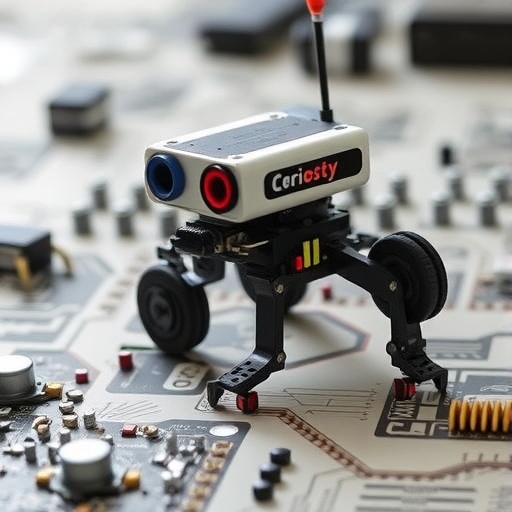In a groundbreaking development within the realm of autonomous navigation, a team of researchers has unveiled a novel optimization method for path planning that exhibits exceptional robustness in uncertain environments. Published on June 3, the research paper titled “Action-Curiosity-Based Deep Reinforcement Learning Algorithm for Path Planning in a Nondeterministic Environment” presents a significant leap in the integration of artificial intelligence with real-world applications, particularly focusing on self-driving vehicles.
The journey towards optimizing path planning for self-driving cars is fraught with challenges, particularly when these vehicles must navigate unpredictable traffic conditions. As AI technologies evolve, researchers are rigorously exploring various strategies to enhance the efficiency and reliability of these systems. The newly developed optimization framework encompasses three critical components: an environment module, a deep reinforcement learning module, and an innovative action curiosity module.
Immersing the TurtleBot3 Waffle robot equipped with sophisticated 360-degree LiDAR sensors in a realistic simulation platform, the team put their method to the test across a series of four diverse scenarios. These tests ranged from straightforward static obstacle courses to exceedingly intricate situations characterized by dynamic and unpredictably moving obstacles. Impressively, their approach showcased remarkable enhancements relative to several state-of-the-art baseline algorithms. Key performance indicators demonstrated significant improvements in convergence speed, training duration, path planning success rate, and the average reward received by the agents.
.adsslot_6SL8IjJKfr{width:728px !important;height:90px !important;}
@media(max-width:1199px){ .adsslot_6SL8IjJKfr{width:468px !important;height:60px !important;}
}
@media(max-width:767px){ .adsslot_6SL8IjJKfr{width:320px !important;height:50px !important;}
}
ADVERTISEMENT
At the heart of the method lies the principle of deep reinforcement learning, a paradigm that empowers agents to learn optimal behaviors through real-time interactions with their dynamic surroundings. However, traditional reinforcement learning techniques frequently encounter obstacles such as sluggish convergence rates and suboptimal learning efficiency. To combat these shortcomings, the team introduced the action curiosity module, which serves to amplify the learning efficiency of agents and encourages them to explore their environments to satisfy their innate curiosity.
This innovative curiosity module introduces a paradigm shift in the agent’s learning dynamics. It motivates the agents to concentrate on states that present moderate difficulty, thereby maintaining a delicate equilibrium between the exploration of completely novel states and the exploitation of already-established rewarding behaviors. The action curiosity module extends previous models of intrinsic curiosity by integrating an obstacle perception prediction network. This network dynamically calculates curiosity rewards based on prediction errors pertinent to obstacles, effectively guiding the agent’s focus toward states that optimize both learning and exploration efficiency.
Crucially, the team also recognized the potential for performance degradation due to excessive exploration in the later stages of training. To address this risk, they employed a cosine annealing strategy, a technique that systematically moderates the weight of the curiosity rewards over time. This gradual adjustment is critical because it stabilizes the training process, fostering a more reliable convergence of the agent’s learned policy.
As the dynamics of autonomous navigation continue to evolve, this research paves the way for future enhancements to the path planning strategy. The team envisions the integration of advanced motion prediction techniques, which would significantly elevate the adaptability of their method to highly dynamic and stochastic environments. Such advancements promise to bridge the gap between experimental success and practical application, ultimately contributing to the development of safer and more reliable autonomous driving systems.
The implications of this research extend far beyond the confines of academic inquiry. As self-driving technology progresses, enhancing path planning algorithms will play a crucial role in ensuring the safety and efficiency of autonomous vehicles operating in real-world conditions. By leveraging sophisticated reinforcement learning strategies and embracing a curiosity-driven approach, researchers are not only addressing existing challenges but are also contributing to the broader discourse on AI and machine learning applications in transportation.
In summary, the action-curiosity-based deep reinforcement learning algorithm represents a pivotal innovation in the field of autonomous navigation. By embracing the complexities of nondeterministic environments, this method holds the potential to revolutionize how autonomous vehicles operate in unpredictable settings. As researchers continue to refine these algorithms and explore their applications, the future of self-driving technology appears increasingly promising, laying the groundwork for a new era of intelligent transportation systems.
In conclusion, the research community remains excited about the potential applications of this optimization method, which may serve as a foundation for future developments in autonomous systems. With ongoing research and collaboration, the journey toward fully autonomous vehicles that navigate safely and efficiently in complex environments draws nearer, bringing with it a future where technology and transportation coexist harmoniously.
Subject of Research: Optimization of Path Planning for Self-Driving Cars
Article Title: Action-Curiosity-Based Deep Reinforcement Learning Algorithm for Path Planning in a Nondeterministic Environment
News Publication Date: June 3, 2025
Web References: Intelligent Computing
References: DOI: 10.34133/icomputing.0140
Image Credits: Junxiao Xue et al.
Keywords
Autonomous Navigation, Deep Reinforcement Learning, Path Planning, Self-Driving Cars, Action Curiosity Module, Stochastic Environments, Machine Learning.
Tags: action curiosity algorithm for robotsAI integration in real-world applicationsautonomous navigation technologydeep reinforcement learning for path planningdynamic obstacle navigation strategiesenhancing efficiency of AI systemsimproving reliability of autonomous systemsLiDAR sensor applications in roboticsnovel optimization methods in AIoptimizing path planning in uncertain environmentsself-driving vehicle navigation challengesTurtleBot3 Waffle robot testing





